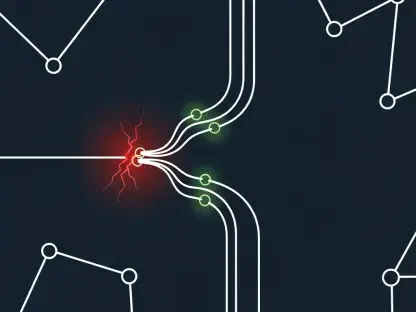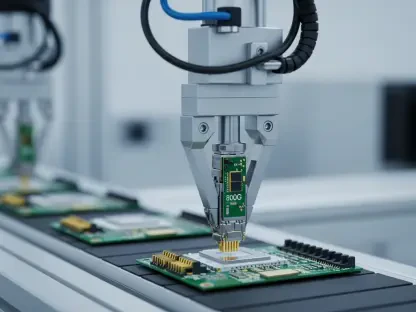The advancements in artificial intelligence (AI) are reshaping the landscape of network design in ways reminiscent of how the Internet revolutionized connectivity in the last century. During events such as Cisco Live, it has become evident that AI is influencing network infrastructures, requiring new levels of programmability, observability, and optimization. This transformation affects more than just the technical aspects—it influences the roles and responsibilities of developers, who must now incorporate AI capabilities into networking solutions. The parallels drawn between the impact of the Internet in the 1990s and AI today create a compelling narrative for understanding the potential future of networking.
Evolving Networking Infrastructures
From Static Routers to Programmable Platforms
The transition from traditional static routers to programmable platforms is reminiscent of the shift to cloud-native infrastructures that adopted containers and application programming interfaces (APIs). This change is spearheaded by innovations such as Cisco’s Data Processing Unit (DPU)-enabled top-of-rack switches. These switches integrate fundamental functions like firewalling and load balancing directly into the network fabric, negating the necessity for standalone devices. This evolution aligns networking with the modern “GitOps” approach, replacing older “ticket ops” models. By embedding capabilities within the fabric, networks become more responsive and adaptable to changing needs.
Programmability transforms network services into customizable entities, much like software-defined systems, allowing for efficient delivery from the switch. This shift eliminates the dependency on virtual machines or sidecar containers for network services, streamlining operations. The inclusion of tools such as Tetragon for runtime protection and observability frameworks using extended Berkeley Packet Filter (eBPF) further enhances this model. It provides flexibility in coding and managing network operations, breaking away from traditional models and introducing an era where network configurations can be rapidly adjusted based on dynamic demands.
Leveraging AI in Network Debugging
AI’s potential in network debugging is significant, with models like the Cisco Foundation AI Security Model poised to transform security handling. Introduced at Cisco Live, this open-source framework is trained on millions of security-specific tokens, enhancing threat detection and response capabilities. Complementary to this is the Deep Network Model, optimized for enhancing network operations through AI-driven insights. With the agentic user interface AI Canvas, network telemetry can be harnessed at scale, allowing machine reasoning to extract actionable insights promptly. This addresses the ongoing requirements for maintaining stable and secure network environments.
AI’s integration into networking offers a supporting role rather than replacing traditional network engineering expertise. While AI-equipped networks provide access to vast datasets, facilitating efficient operations, it emphasizes collaboration rather than substitution. The incorporation of machine reasoning to process extensive telemetry is not simply a tech upgrade; it signifies an evolution in managing massive network architectures. As highlighted by industry leaders, this advancement ensures that network integrity is sustained, even as systems become increasingly complex and data-intensive.
The Impact on Developer Roles
Merging Application Logic and Network Control
AI integration is dissolving the conventional boundaries between applications and their infrastructure, prompting a rethink in architecture. This evolution is apparent as both models and silicon technologies become more specialized, with reduced sizes and heightened programmability. Such advancements shorten time to market for new technologies and blur distinctions between application and infrastructure layers. Developers now require enhanced visibility into how elements like model design, network bandwidth, and inference placement interact, particularly because latency and congestion issues can adversely affect network performance.
AI workloads encourage alignment with network topology, as seen in workload distribution strategies such as pipeline parallelism and inference placement optimization. Pre-caching model shards near compute nodes signify how developers must adopt infrastructure-thinking methodologies for improved performance. These improvements hinge not solely on Graphics Processing Unit (GPU) efficiency but also on managing data flow across complex network architectures. This perspective underscores that modern networking demands integration across applications, often requiring developers to consider broader system dynamics.
Pursuing Network Programmability
Reaching the longstanding objective of network programmability, known as NetDevOps, is gaining traction with AI’s rise. Historically considered challenging due to non-standard interfaces and closed systems, this ambition now seems attainable as infrastructures align strategically with overarching technological domains. Jim Frey’s insights capture this shift, where AI catalyzes reimagining strategies for infrastructure teams and equipment providers. Open standards and collaborative approaches encourage greater programmability across networks, opening pathways to harmonization between application logic and network management.
Cisco’s trajectory towards a future network control plane granting declarative algorithm access to bandwidth and latency parameters reflects its visionary approach. Such changes, as emphasized by experts like Patrick LeMaistre, mark a transformation in treating AI as a platform rather than a mere workload. By doing so, the evolution redefines network roles and facilitates the transition toward coalescence between application and network control, a shift that could revolutionize network efficiency and accountability.
The Future of Networking
Integrating AI and Intelligent Networking
AI’s influence on networking suggests a future where programmers hold direct control over network infrastructures, altering traditional roles. Such integration propels developers into the forefront as they navigate complex landscapes requiring both technical acumen and inventive thinking. This shift challenges long-standing practices, focusing on embedding intelligence within network operations to maintain relevance amidst increasing demands.
Key insights emphasize that AI’s presence in networking requires adaptability, where achieving a balance between machine capabilities and human oversight remains crucial. Collaborations across technology and development communities signal a shared responsibility in shaping this new era. As networks evolve, so do opportunities and challenges, demanding readiness to embrace innovation and maintain competitive advantages in an ever-changing digital world.
Redefining Technical and Development Roles
The evolution of artificial intelligence (AI) is dramatically altering the field of network design, echoing the transformative effects of the Internet on connectivity during the last century. At industry events like Cisco Live, it’s apparent that AI is profoundly impacting network infrastructures, demanding enhanced levels of programmability, observability, and optimization. This shift requires network developers to not only focus on technical upgrades but also to adapt their roles and responsibilities to include integrating AI into their networking solutions. The comparison between the revolutionary impact of the Internet in the 1990s and AI’s influence today offers a fascinating perspective on the anticipated future of networking. AI isn’t just a technical innovation; it represents an evolving paradigm that could redefine how we approach connectivity. As we witness AI’s integration into network solutions, it underscores a pivotal moment in technological advancement, comparable to past milestones in communication and connectivity development.









